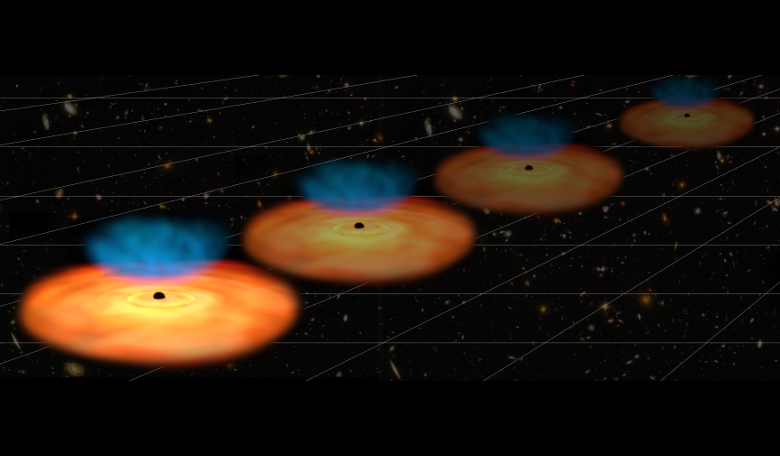It seems there is a problem with the early history of the Universe and to fix it, scientists will have to invoke a new type of physics say the authors of a new study, who after looked at a large sample of distant ‘active’ galaxies found a flaw with our current understanding of how the cosmos has expanded.
To explain how the Universe has evolved and therefore expanded since it came into being with a big bang, scientists use a model known as lambda CDM (or ΛCDM). The symbol for Lambda Λ refers to Albert Einstein’s cosmological constant which describes the energy density of space – a characteristic that we now associate with dark energy, while the CDM part stands for Cold Dark Matter.
The model is frequently referred to as the standard model because it ties together many of the cosmological phenomena that scientists use to infer why the Universe looks the way it does as we see it today.
This includes elements such as the existence and structure of the cosmic microwave background (CMB) and how galaxies have assembled themselves into massive superclusters which seem to follow a hierarchy arrangement. Consequently, the model has proved itself time and time again to be a worthy contender as the default theory in which to describe how the Universe works.
Nonetheless, although it describes many phenomena with faithful precision, certain epochs in the Universe’s history are notoriously difficult to study because pinning down exactly how fast the cosmos has expanded, especially in the beginning, is incredibly difficult to do.
Researchers have in the past used the consistent brightness of type-1A supernovas to help calculate distances but as successful as this has been, light from these violent stellar explosions can only help scientists look so far back – certainly not all the way back to the beginning anyway.
However, three years ago, Guido Risaliti of Università di Firenze, Italy and Elisabeta Lusso of Durham University, realised that a well-known relation between the ultraviolet (UV) and X-ray brightness of quasars could be used to estimate the distance to some of these most ancient sources. Quasars are one of the most brightest and energetic objects around and as such they are a lot easier to spot in the Universe’s infant days.
“Using quasars as standard candles has great potential, since we can observe them out to much greater distances from us than type-Ia supernovas, and so use them to probe much earlier epochs in the history of the cosmos,” explains Lusso.
So, using X-ray data from over 7000 quasars, and combining them with UV observations from the ground-based Sloan Digital Sky Survey, along with additional information from NASA’s Chandra and Swift X-ray observatories, the duo set about calculating the expansion history of the Universe.
“Such a large sample enabled us to scrutinise the relation between X-ray and ultraviolet emission of quasars in painstaking detail, which greatly refined our technique to estimate their distance,” says Risaliti.
The result? The duo found a correlation with type-1A supernova distance calculations for the past eight billion years, but prior to that, a problem arose. “In the earlier phases that we can only probe with quasars, we find a discrepancy between the observed evolution of the Universe and what we would predict based on the standard cosmological model,” explained Lusso.
At the moment, the discrepancy is big enough to infer that extra physics are needed to reconcile the duo’s data with what has become expected according to standard model of cosmology. “One of the possible solutions would be to invoke an evolving dark energy, with a density that increases as time goes by,” says Risaliti.
The idea of an evolving dark energy to account for this disparity, could coincidently help to resolve another burgeoning problem in cosmology - that of the Hubble constant which seeks to explain the current rate of cosmic expansion.
Recent estimates of the Hubble constant in the local Universe based on supernova data compared with those calculated for large scale structures such as galaxy clusters based on CMB data in the early Universe, don’t match up. And as yet, there is no way to reconcile them or make them fit.
“This model is quite interesting because it might solve two puzzles at once, but the jury is definitely not out yet and we’ll have to look at many more models in great detail before we can solve this cosmic conundrum,” says Risaliti.
Help to refine the duo’s models should come in the form of ESA’s Euclid mission which is scheduled for launch in 2022. Euclid’s mission is to map the geometry of the dark Universe by investigating the distance-redshift relationship and the evolution of cosmic structures over the past ten billion years.











